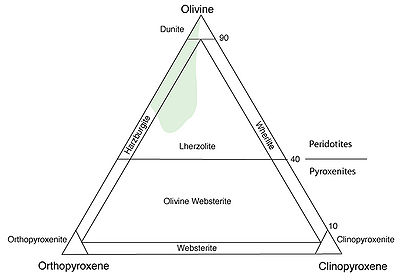- Roca ultrabásica
-
Roca ultrabásica
Las rocas ultrabásicas (también referida como ultramáficas) son rocas ígneas y meta-ígneas con muy bajo sílice (menos de 45%), generalmente >18% MgO, alto FeO, bajo potasio, y se compone de usualmente más de 90% de minerales básicos (coloreados negruzcos, alto contenido de magnesio y de hierro). El manto terrestre es considerado como compuesto de rocas ultrabásicas.
Contenido
Rocas intrusivas ultrabásicas
 Diagrama de Clasificación IUGS para rocas intrusivas ultrabásicas basado en % modales de minerales básicos. El área verde representa peridotitas típicas del manto
Diagrama de Clasificación IUGS para rocas intrusivas ultrabásicas basado en % modales de minerales básicos. El área verde representa peridotitas típicas del manto
Las rocas intrusivas ultrabásicas se ubican frecuentemente en intrusiones ultrabásicas grandes y estratificas, donde diferenciados tipos de rocas frecuentemente se estratifican.[1] Tales rocas acumuladas no representan la química del magma del cual se cristalizaron. Esas ultrabásicas intrusivas incluyen las dunitas, peridotitas y piroxenitas. Otras raras variedades incluye a la troctolita en más grande porcentaje de plagioclasas cálcicas. Esos grados dentro de anortositas. Tanto gabro como norita se hallan con frecuencia en las partes superiores de las secuecnias de ultrabásicos en capas. También se halla hornblendita y, más raramente flogopitita.
Rocas volcánicas ultrabásicas
Las rocas volcánicas ultrabásicas son raras de verlas fuera del Eón Arcaico y están esencialmente restringuidas al Neoproterozoico o más temprano, aunque algunas lavas boninitas corrientemente erupcionaron dentro de estratos de arcos (Manus Trough, Nueva Guinea). Las rocas subvolcánicas ultrabásicas y los diques persisten más, pero son raras. Muchas de las lavas producidas en la luna Io pueden ser ultrabásicas, como lo evidencian sus temperaturas que son más altas que las erupciones básicas terrestres.
Los ejemplos incluyen a komatita[2] y basalto picrítico. Las komatitas pueden ser albergadas en depósitos de menas de níquel.[3]
Rocas ultrapotásicas ultrabásicas
Técnicamente las rocas ultrapotásicas y melilíticas se consideran un grupo separado, basados en criterios modelizados de fusión, pero hay rocas ultrapotásicas y de alto sílice saturado con >18% MgO y puede ser considerado "ultrabásico".
Ultrapotassic, ultramafic igneous rocks such as lamprophyre, lamproite and kimberlite are known to have reached the surface of the Earth. Although no modern eruptions have been observed, analogues are preserved.
Most of these rocks occur as dikes, diatremes, lopoliths or laccoliths, and very rarely, intrusions. Most kimberlite and lampproite occurrences occur as volcanic and subvolcanic diatremes and maars; lavas are virtually unknown.
Vents of Proterozoic lamproite (Argyle diamond mine), and Cenozoic lamproite (Gaussberg, Antarctica) are known, as are vents of Devonian lamprophyre (Scotland). Kimberlite pipes in Canadá, Rusia and South Africa have incompletely-preserved tephra and agglomerate facies.
These are generally diatreme events and as such are not lava flows although tephra and ash deposits are partially preserved. These represent low-volume volatile melts and attain their ultramafic chemistry via a different process to typical ultramafic rocks. Carbonatites are rare high-carbonate, low-silica igneous rocks.
== Metamorphic ultramafic rocks ==Metamorphism of ultramafic rocks in the presence of water and/or carbon dioxide results in two main classes of metamorphic ultramafic rock; talc carbonate and serpentinite.
Talc carbonation reactions occur in ultramafic rocks at lower greenschist through to granulite facies metamorphism when the rock in question is subjected to metamorphism and the metamorphic fluid has more than 10% molar proportion of carbon dioxide.
When the metamorphic fluids in contact with the ultramafic rock have less than 10% CO2 the metamorphic reactions favor serpentinisation reactions, resulting in chlorite-serpentine-amphibole type assemblages.
Distribution in space and time
The majority of ultramafic rocks are exposed in orogenic belts, and predominate in Archaean and Proterozoic terranes. Ultramafic magmas in the Phanerozoic are rarer, and there are very few recognised true ultramafic lavas in the Phanerozoic.
Many surface exposures of ultramafic rocks occur in ophiolite complexes where deep mantle-derived rocks have been obducted onto continental crust along and above subduction zones.
Ultramafic rocks and the regolith
Plantilla:Cleanup-section Where ultramafic rocks (in particular, the types which have low amounts of nutrient elements such as calcium, potassium and phosphorus) are exposed on the surface, the high metal content of the rocks creates unique vegetation. Examples are the ultramafic woodlands and ultramafic barrens of the Appalachian mountains and piedmont, the "wet maquis" of the New Caledonia rain forests, and the ultramafic forests of Mount Kinabalu and other peaks in Sabah, Malaysia. Vegetation is typically stunted, and is sometimes home to endemic species adapted to the metallic soils.
Often thick, magnesite-calcrete caprock, clayey laterite and duricrust forms over ultramafic rocks in tropical and subtropical environments. Particular floral assemblages associated with highly nickeliferous ultramafic rocks are indicative tools for mineral exploration.
Weathered ultramafic rocks may form lateritic nickel ore deposits[4] [5]
Enlaces internos
- Tipos de rocas ultrabásicas: peridotita, dunita, norita, esexita, komatita.
- Cumulate rocks and rock types: chromitite, magnetite, anorthosite
- Ultramafic-associated ore deposits: Lateritic nickel ore deposits, kambalda type komatiitic nickel ore deposits, diamond
- Kimberlite, lamproite, lamprophyre
- Ophiolite
- Ultramafic to mafic layered intrusions
- Igneous differentiation, fractional crystallisation
Referencias
- ↑ Ballhaus, C.G. & Glikson, A.Y., 1995, Petrología of layered mafic-ultramafic intrusions of the Giles Complex, western Musgrave Block, central Australia. AGSO Journal, 16/1&2: 69-90.
- ↑ Hill R.E.T, Barnes S.J., Gole M.J., and Dowling S.E., 1990. Physical volcanology of komatiites; A field guide to the komatiites of the Norseman-Wiluna Greenstone Belt, Eastern Goldfields Province, Yilgarn Block, Australia Occidental, Geological Society of Australia. ISBN 0-909869-55-3
- ↑ Lesher, C.M., Arndt, N.T., and Groves, D.I., 1984, Genesis of komatiite-associated nickel sulfide deposits at Kambalda, Western Australia: A distal volcanic model, in Buchanan, D.L., and Jones, M.J. (Editores), Sulphide Deposits in Mafic and Ultramafic Rocks, Institution of Mining and Metallurgy, Londres, pp. 70-80.
- ↑ Golightly, J.P. (1981): Nickeliferous Laterite Deposits. Economic Geology 75, 710-735
- ↑ Schellmann, W. (1983): Geochemical principles of lateritic nickel ore formation. Proceedings of the 2. International Seminar on Lateritisation Processes, Sao Paulo, 119-135
Categorías: Rocas básicas | Rocas ígneas | Rocas metamórficas
Wikimedia foundation. 2010.
